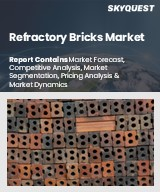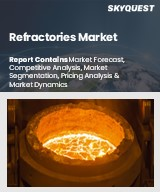
|
시장보고서
상품코드
1696954
세계의 플라이 애시 벽돌 제조기 시장 조사 보고서 : 산업 분석, 규모, 점유율, 성장, 동향 및 예측(2025-2033년)Global Fly Ash Brick Making Machine Market Research Report- Industry Analysis, Size, Share, Growth, Trends and Forecast 2025 to 2033 |
||||||
세계의 플라이 애시 벽돌 제조기 시장 규모는 2024년 5억 8,050만 달러에서 2033년 8억 6,491만 달러에 이르고, 2026-2033년의 예측 기간 동안 4.53%의 견고한 연평균 성장률(CAGR)을 보일 것으로 예측됩니다.
플라이 애시 벽돌 제조기 시장은 지속 가능한 건축자재에 대한 수요 증가로 인해 강력한 성장세를 보이고 있습니다. 건설 업계가 환경 발자국을 줄이기 위해 노력하는 가운데, 산업 폐기물을 주원료로 사용하는 플라이애시 벽돌은 친환경적인 특성과 우수한 성능으로 인기를 끌고 있습니다. 플라이애시 벽돌은 높은 압축강도, 단열성, 내화성, 내수성 등 여러 가지 장점을 가지고 있어 기존 점토 벽돌을 대체할 수 있는 매력적인 대안이 되고 있습니다. 지속 가능한 건축 방식에 대한 인식이 높아지면서 건설업체와 개발업체가 친환경 건축 방식을 우선시하기 때문에 플라이 애시 벽돌 제조기 채택을 촉진하고 있습니다.
환경적 이점 외에도 플라이 애시 벽돌 제조기 시장은 신흥 경제국의 도시화와 인프라 개발이 증가함에 따라 영향을 받고 있습니다. 도시가 확장되고 새로운 건설 프로젝트가 시작됨에 따라 비용 효율적이고 내구성이 뛰어난 건축자재에 대한 수요가 급증하고 있습니다. 플라이애시 벽돌은 지속가능성에 기여할 뿐만 아니라 기존 벽돌에 비해 저렴한 비용으로 생산할 수 있어 경제적 이점이 있습니다. 이러한 비용 효율성은 원료인 플라이애시의 가용성 증가와 함께 소규모 및 대규모 제조업체를 막론하고 시장 성장을 주도하고 있습니다.
향후 플라이 애시 벽돌 제조기 시장은 상당한 기술적 진보와 혁신이 예상됩니다. 제조업체들은 첨단 혼합 및 성형 기술과 같은 기능을 통합하여 벽돌 제조 공정의 효율성과 자동화에 초점을 맞추었습니다. 또한, 제조업의 디지털화 추세는 실시간 모니터링 및 데이터 분석 기능을 제공하는 스마트 머신의 개발로 이어질 가능성이 높습니다. 시장이 진화함에 따라 지속가능성, 효율성, 기술 혁신에 중점을 두는 것이 플라이 애시 벽돌 제조의 미래를 형성하고 건설 산업에서 중요한 기업로 자리매김할 것입니다.
당사의 보고서는 고객에게 다양한 산업 및 시장에 대한 종합적이고 실용적인 통찰력을 제공하기 위해 세심하게 작성되었습니다. 각 보고서는 시장 상황을 완전히 이해하기 위해 몇 가지 중요한 요소를 포함하고 있습니다.
시장 개요: 정의, 분류, 산업 현황에 대한 개요 등 시장에 대한 자세한 소개.
시장 성장 촉진요인 : 시장 성장에 영향을 미치는 주요 촉진요인, 억제요인, 시장 성장 촉진요인 및 과제를 상세하게 분석합니다. 이 섹션에서는 기술 발전, 규제 변화, 새로운 트렌드 등의 요인을 검토합니다.
세분화 분석 : 제품 유형, 용도, 최종 사용자, 지역 등의 기준에 따라 시장을 명확한 부문으로 분류합니다. 이 분석을 통해 각 부문의 성과와 잠재력을 파악할 수 있습니다.
경쟁 구도: 시장 점유율, 제품 포트폴리오, 전략적 이니셔티브, 재무 실적 등 주요 시장 기업의 종합적인 평가. 주요 기업들이 채택하고 있는 경쟁 역학 및 주요 전략에 대한 고찰을 제공합니다.
시장 예측 : 과거 데이터와 현재 시장 상황을 바탕으로 일정 기간 동안 시장 규모와 성장 추세를 예측합니다. 여기에는 정량적 분석과 미래 시장 궤적을 보여주는 그래프 표시가 포함됩니다.
지역 분석 : 지역별 시장 성과를 평가하고 주요 시장 및 지역 동향을 파악할 수 있습니다. 지역 시장 역학 및 비즈니스 기회를 이해하는 데 도움이 됩니다.
새로운 트렌드와 기회 : 현재 시장 동향과 새로운 시장 동향, 기술 혁신, 잠재적 투자 대상 분야를 파악합니다. 미래 시장 개척 및 성장 전망에 대한 통찰력을 제공합니다.
목차
제1장 서문
제2장 주요 요약
- 시장 하이라이트
- 세계 시장 현황
제3장 플라이 애시 벽돌 제조기 산업 분석
- 서론 : 시장 역학
- 시장 성장 촉진요인
- 시장 성장 억제요인
- 시장 기회
- 산업 동향
- Porter의 Five Forces 분석
- 시장의 매력 분석
제4장 밸류체인 분석
- 밸류체인 분석
- 원재료 분석
- 원재료 리스트
- 원재료 제조업체 리스트
- 주요 원재료 가격 동향
- 잠재적 바이어 리스트
- 마케팅 채널
- 직접 마케팅
- 간접 마케팅
- 마케팅 채널 발전 동향
제5장 세계의 플라이 애시 벽돌 제조기 시장 분석 : 유형별
- 유형별 개요
- 유형별 과거 및 예측 데이터 분석
- 반자동
- 전자동
제6장 세계의 플라이 애시 벽돌 제조기 시장 분석 : 용량별
- 용량별 개요
- 용량별 과거 및 예측 데이터 분석
- 100 BPH까지
- 100 BPH에서 300 BPH까지
- 300 BPH에서 500 BPH까지
- 500 BPH에서 700 BPH까지
- 700 BPH 이상
제7장 세계의 플라이 애시 벽돌 제조기 시장 분석 : 전력별
- 전력별 개요
- 전력별 과거 및 예측 데이터 분석
- 20 마력까지
- 20 마력에서 25 마력까지
- 25 마력에서 30 마력까지
- 30 마력 이상
제8장 세계의 플라이 애시 벽돌 제조기 시장 분석 : 유통 채널별
- 유통 채널별 개요
- 유통 채널별 과거 및 예측 데이터 분석
- 직접 판매
- 간접 판매
제9장 세계의 플라이 애시 벽돌 제조기 시장 분석 : 지역별
- 지역별 전망
- 서론
- 북미의 판매 분석
- 개요, 분석과 예측
- 북미 : 부문별
- 북미 : 국가별
- 미국
- 캐나다
- 멕시코
- 유럽의 판매 분석
- 개요, 분석과 예측
- 유럽 : 부문별
- 유럽 : 국가별
- 영국
- 프랑스
- 독일
- 이탈리아
- 러시아
- 기타 유럽
- 아시아태평양의 판매 분석
- 개요, 분석과 예측
- 아시아태평양 : 부문별
- 아시아태평양 : 국가별
- 중국
- 인도
- 일본
- 한국
- 호주
- 동남아시아
- 기타 아시아태평양
- 라틴아메리카의 판매 분석
- 개요, 분석과 예측
- 라틴아메리카 : 부문별
- 라틴아메리카 : 국가별
- 브라질
- 아르헨티나
- 페루
- 칠레
- 기타 라틴아메리카
- 중동 및 아프리카의 판매 분석
- 개요, 분석과 예측
- 중동 및 아프리카 : 부문별
- 중동 및 아프리카 : 국가별 리스트
- 사우디아라비아
- 아랍에미리트(UAE)
- 이스라엘
- 남아프리카공화국
- 기타 중동 및 아프리카
제10장 플라이 애시 벽돌 제조기 기업 경쟁 구도
- 플라이 애시 벽돌 제조기 시장 경쟁
- 제휴/협업/협정
- 인수합병(M&A)
- 신제품 발매
- 기타 개발
제11장 기업 개요
- 주요 기업의 시장 점유율 분석
- 시장 집중도
- Benny Industries
- Revomac Industries
- Laxmi Engineering Works
- Steel Land Machinery Work
- Q Green Techcon
- ASH Brick Engineering
- GaogeTech
- Gongyi Liejianggou Machinery Factory
- Hollow Block Machine
- Hydraform International
Global Fly Ash Brick Making Machine Market size is anticipated to grow from USD 580.5 Million in 2024 to USD 864.91 Million by 2033, showcasing a robust Compound Annual Growth Rate (CAGR) of 4.53% during the forecast period of 2026 to 2033.
The fly ash brick making machine market is experiencing robust growth, driven by the increasing demand for sustainable construction materials. As the construction industry seeks to reduce its environmental footprint, fly ash bricks, which utilize industrial waste as a primary raw material, are gaining popularity due to their eco-friendly properties and superior performance. These bricks offer several advantages, including high compressive strength, thermal insulation, and resistance to fire and water, making them an attractive alternative to traditional clay bricks. The growing awareness of sustainable building practices is propelling the adoption of fly ash brick making machines, as builders and developers prioritize green construction methods.
In addition to environmental benefits, the fly ash brick making machine market is influenced by the rising urbanization and infrastructure development across emerging economies. As cities expand and new construction projects emerge, the demand for cost-effective and durable building materials is surging. Fly ash bricks not only contribute to sustainability but also provide economic advantages, as they can be produced at a lower cost compared to conventional bricks. This cost-effectiveness, combined with the increasing availability of fly ash as a raw material, is driving the growth of the market, attracting both small-scale and large-scale manufacturers.
Looking ahead, the fly ash brick making machine market is expected to witness significant technological advancements and innovations. Manufacturers are focusing on enhancing the efficiency and automation of brick production processes, incorporating features such as advanced mixing and molding technologies. Additionally, the growing trend of digitalization in manufacturing is likely to lead to the development of smart machines that offer real-time monitoring and data analytics capabilities. As the market evolves, the emphasis on sustainability, efficiency, and technological innovation will shape the future of fly ash brick making, positioning it as a key player in the construction industry.
Our reports are meticulously crafted to provide clients with comprehensive and actionable insights into various industries and markets. Each report encompasses several critical components to ensure a thorough understanding of the market landscape:
Market Overview: A detailed introduction to the market, including definitions, classifications, and an overview of the industry's current state.
Market Dynamics: In-depth analysis of key drivers, restraints, opportunities, and challenges influencing market growth. This section examines factors such as technological advancements, regulatory changes, and emerging trends.
Segmentation Analysis: Breakdown of the market into distinct segments based on criteria like product type, application, end-user, and geography. This analysis highlights the performance and potential of each segment.
Competitive Landscape: Comprehensive assessment of major market players, including their market share, product portfolio, strategic initiatives, and financial performance. This section provides insights into the competitive dynamics and key strategies adopted by leading companies.
Market Forecast: Projections of market size and growth trends over a specified period, based on historical data and current market conditions. This includes quantitative analyses and graphical representations to illustrate future market trajectories.
Regional Analysis: Evaluation of market performance across different geographical regions, identifying key markets and regional trends. This helps in understanding regional market dynamics and opportunities.
Emerging Trends and Opportunities: Identification of current and emerging market trends, technological innovations, and potential areas for investment. This section offers insights into future market developments and growth prospects.
SEGMENTATION COVERED IN THE REPORT
By Type
- Semi-automatic
- Fully-automatic
By Capacity
- Up to 100 BPH (Bricks Per Hour)
- 100 BPH to 300 BPH
- 300 BPH to 500 BPH
- 500 BPH to 700 BPH
- Above 700 BPH
By Power
- Up to 20 Hp
- 20 Hp to 25 Hp
- 25 Hp to 30 Hp
- Above 30 Hp
By Distribution Channel
- Direct Sales
- Indirect Sales
- COMPANIES PROFILED
- Benny Industries
- Revomac Industries
- Laxmi Engineering Works
- Steel Land Machinery Work
- Q Green Techcon
- ASH Brick Engineering
- GaogeTech
- Gongyi Liejianggou Machinery Factory
- Hollow Block Machine
- Hydraform International.
- The above list can be customized.
TABLE OF CONTENTS
1. PREFACE
- 1.1. Report Description
- 1.1.1 Objective
- 1.1.2 Target Audience
- 1.1.3 Unique Selling Proposition (USP) & offerings
- 1.2. Research Scope
- 1.3. Research Methodology
- 1.3.1 Market Research Process
- 1.3.2 Market Research Methodology
2. EXECUTIVE SUMMARY
- 2.1. Highlights of Market
- 2.2. Global Market Snapshot
3. FLY ASH BRICK MAKING MACHINE INDUSTRY ANALYSIS
- 3.1. Introduction - Market Dynamics
- 3.2. Market Drivers
- 3.3. Market Restraints
- 3.4. Opportunities
- 3.5. Industry Trends
- 3.6. Porter's Five Force Analysis
- 3.7. Market Attractiveness Analysis
- 3.7.1 Market Attractiveness Analysis By Type
- 3.7.2 Market Attractiveness Analysis By Capacity
- 3.7.3 Market Attractiveness Analysis By Power
- 3.7.4 Market Attractiveness Analysis By Distribution Channel
- 3.7.5 Market Attractiveness Analysis By Region
4. VALUE CHAIN ANALYSIS
- 4.1. Value Chain Analysis
- 4.2. Raw Material Analysis
- 4.2.1 List of Raw Materials
- 4.2.2 Raw Material Manufactures List
- 4.2.3 Price Trend of Key Raw Materials
- 4.3. List of Potential Buyers
- 4.4. Marketing Channel
- 4.4.1 Direct Marketing
- 4.4.2 Indirect Marketing
- 4.4.3 Marketing Channel Development Trend
5. GLOBAL FLY ASH BRICK MAKING MACHINE MARKET ANALYSIS BY TYPE
- 5.1. Overview By Type
- 5.2. Historical and Forecast Data Analysis By Type
- 5.3. Semi-automatic Historic and Forecast Sales By Regions
- 5.4. Fully-automatic Historic and Forecast Sales By Regions
6. GLOBAL FLY ASH BRICK MAKING MACHINE MARKET ANALYSIS BY CAPACITY
- 6.1. Overview By Capacity
- 6.2. Historical and Forecast Data Analysis By Capacity
- 6.3. Up to 100 BPH (Bricks Per Hour) Historic and Forecast Sales By Regions
- 6.4. 100 BPH to 300 BPH Historic and Forecast Sales By Regions
- 6.5. 300 BPH to 500 BPH Historic and Forecast Sales By Regions
- 6.6. 500 BPH to 700 BPH Historic and Forecast Sales By Regions
- 6.7. Above 700 BPH Historic and Forecast Sales By Regions
7. GLOBAL FLY ASH BRICK MAKING MACHINE MARKET ANALYSIS BY POWER
- 7.1. Overview By Power
- 7.2. Historical and Forecast Data Analysis By Power
- 7.3. Up to 20 Hp Historic and Forecast Sales By Regions
- 7.4. 20 Hp to 25 Hp Historic and Forecast Sales By Regions
- 7.5. 25 Hp to 30 Hp Historic and Forecast Sales By Regions
- 7.6. Above 30 Hp Historic and Forecast Sales By Regions
8. GLOBAL FLY ASH BRICK MAKING MACHINE MARKET ANALYSIS BY DISTRIBUTION CHANNEL
- 8.1. Overview By Distribution Channel
- 8.2. Historical and Forecast Data Analysis By Distribution Channel
- 8.3. Direct Sales Historic and Forecast Sales By Regions
- 8.4. Indirect Sales Historic and Forecast Sales By Regions
9. GLOBAL FLY ASH BRICK MAKING MACHINE MARKET ANALYSIS BY GEOGRAPHY
- 9.1. Regional Outlook
- 9.2. Introduction
- 9.3. North America Sales Analysis
- 9.3.1 Overview, Historic and Forecast Data Sales Analysis
- 9.3.2 North America By Segment Sales Analysis
- 9.3.3 North America By Country Sales Analysis
- 9.3.4 United States Sales Analysis
- 9.3.5 Canada Sales Analysis
- 9.3.6 Mexico Sales Analysis
- 9.4. Europe Sales Analysis
- 9.4.1 Overview, Historic and Forecast Data Sales Analysis
- 9.4.2 Europe By Segment Sales Analysis
- 9.4.3 Europe By Country Sales Analysis
- 9.4.4 United Kingdom Sales Analysis
- 9.4.5 France Sales Analysis
- 9.4.6 Germany Sales Analysis
- 9.4.7 Italy Sales Analysis
- 9.4.8 Russia Sales Analysis
- 9.4.9 Rest Of Europe Sales Analysis
- 9.5. Asia Pacific Sales Analysis
- 9.5.1 Overview, Historic and Forecast Data Sales Analysis
- 9.5.2 Asia Pacific By Segment Sales Analysis
- 9.5.3 Asia Pacific By Country Sales Analysis
- 9.5.4 China Sales Analysis
- 9.5.5 India Sales Analysis
- 9.5.6 Japan Sales Analysis
- 9.5.7 South Korea Sales Analysis
- 9.5.8 Australia Sales Analysis
- 9.5.9 South East Asia Sales Analysis
- 9.5.10 Rest Of Asia Pacific Sales Analysis
- 9.6. Latin America Sales Analysis
- 9.6.1 Overview, Historic and Forecast Data Sales Analysis
- 9.6.2 Latin America By Segment Sales Analysis
- 9.6.3 Latin America By Country Sales Analysis
- 9.6.4 Brazil Sales Analysis
- 9.6.5 Argentina Sales Analysis
- 9.6.6 Peru Sales Analysis
- 9.6.7 Chile Sales Analysis
- 9.6.8 Rest of Latin America Sales Analysis
- 9.7. Middle East & Africa Sales Analysis
- 9.7.1 Overview, Historic and Forecast Data Sales Analysis
- 9.7.2 Middle East & Africa By Segment Sales Analysis
- 9.7.3 Middle East & Africa By Country Sales Analysis
- 9.7.4 Saudi Arabia Sales Analysis
- 9.7.5 UAE Sales Analysis
- 9.7.6 Israel Sales Analysis
- 9.7.7 South Africa Sales Analysis
- 9.7.8 Rest Of Middle East And Africa Sales Analysis
10. COMPETITIVE LANDSCAPE OF THE FLY ASH BRICK MAKING MACHINE COMPANIES
- 10.1. Fly Ash Brick Making Machine Market Competition
- 10.2. Partnership/Collaboration/Agreement
- 10.3. Merger And Acquisitions
- 10.4. New Product Launch
- 10.5. Other Developments
11. COMPANY PROFILES OF FLY ASH BRICK MAKING MACHINE INDUSTRY
- 11.1. Top Companies Market Share Analysis
- 11.2. Market Concentration Rate
- 11.3. Benny Industries
- 11.3.1 Company Overview
- 11.3.2 Company Revenue
- 11.3.3 Products
- 11.3.4 Recent Developments
- 11.4. Revomac Industries
- 11.4.1 Company Overview
- 11.4.2 Company Revenue
- 11.4.3 Products
- 11.4.4 Recent Developments
- 11.5. Laxmi Engineering Works
- 11.5.1 Company Overview
- 11.5.2 Company Revenue
- 11.5.3 Products
- 11.5.4 Recent Developments
- 11.6. Steel Land Machinery Work
- 11.6.1 Company Overview
- 11.6.2 Company Revenue
- 11.6.3 Products
- 11.6.4 Recent Developments
- 11.7. Q Green Techcon
- 11.7.1 Company Overview
- 11.7.2 Company Revenue
- 11.7.3 Products
- 11.7.4 Recent Developments
- 11.8. ASH Brick Engineering
- 11.8.1 Company Overview
- 11.8.2 Company Revenue
- 11.8.3 Products
- 11.8.4 Recent Developments
- 11.9. GaogeTech
- 11.9.1 Company Overview
- 11.9.2 Company Revenue
- 11.9.3 Products
- 11.9.4 Recent Developments
- 11.10. Gongyi Liejianggou Machinery Factory
- 11.10.1 Company Overview
- 11.10.2 Company Revenue
- 11.10.3 Products
- 11.10.4 Recent Developments
- 11.11. Hollow Block Machine
- 11.11.1 Company Overview
- 11.11.2 Company Revenue
- 11.11.3 Products
- 11.11.4 Recent Developments
- 11.12. Hydraform International
- 11.12.1 Company Overview
- 11.12.2 Company Revenue
- 11.12.3 Products
- 11.12.4 Recent Developments



















